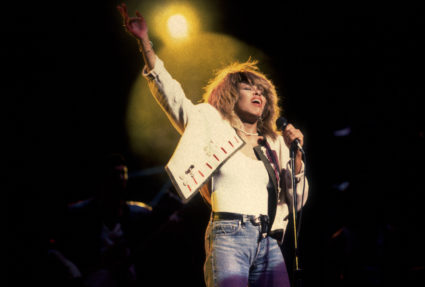
In new Tina Turner doc, the legend wonders how to 'bow out slowly'
Tina Turner is, simply, a natural performer.
The new HBO documentary "Tina" opens with archival footage of the rock 'n' roll pioneer's unmatched stage presence. Turner's in-your-face sensuality and sexuality is clear as the magnetism of her movements pulls you in. Turner herself is heard saying she never formally studied dancing or singing.
But before we're shown the explosion of Turner's energy on stage, Dan Lindsay and T.J. Martin's documentary starts with an interview with a journalist, who asks Turner if anyone has approached her to do the story of her life.
Turner, in an incredibly intimate moment, says she's been asked, but she didn't want to play the part. The journalist then asks if it would be too painful to relive past memories.
"It wasn't a good life," Turner says. It was good "in some areas, but the goodness did not balance the bad. … You don't like to pull out old clothes, you know. It's like old memories, you just want to leave that in the past and done with. Things you don't really want to say, but there comes a time when you do have to say it."

That quote is an instructive one for the documentary, which airs Saturday, March 27, on HBO and will be available for streaming on HBO Max. Turner herself has told her life's story several times. She first spoke of ex-husband Ike Turners' abuse in 1981 in an interview for People magazine. Years after she left her yearslong marriage and music partnership, Turner revealed that she had survived years of domestic violence. "I went through basic torture," she told People's music editor Carl Arrington.
She told her story again in the 1986 autobiography, "I, Tina," which she co-wrote with Kurt Loder. And then, seven years later, it was adapted into the film, "What's Love Got to Do With It." The directors behind "Tina" wanted to retell Turner's story through the lens of the living legend, and not the public perception of Tina Turner.
"Tina's story is one of a billion," Martin said. "She's wholly unique and wholly herself, and I think that's just to her credit. She's always fighting this notion of 'Look at me, for who I am, as an independent individual.'"
By the end of the film, Turner says it was painful to remember certain points in her life, but forgiveness has allowed her to let go of the pain.
"She's kind of gotten to a place of acceptance, that this is her story, and there's no way to separate that story from her," Lindsay said.

The film closes with the glitz of another telling of Turner's story — the "Tina: The Tina Turner Musical," written by Katori Hall — showing shots of adoring fans and celebrities arriving for the production's opening night. After the show, Turner is brought on stage during the standing ovation, and bows.
From her home in Zurich, Switzerland, Turner wonders out loud, "How do you bow out slowly? Just go away." She sighs sharply. There's a sense Turner would like to stop telling the Tina Turner story.
The directors spoke with the PBS NewsHour's Jeffrey Brown on the power of Turner's performances, how the 81-year-old was involved with the film, and how this may be her final word about her life's story.
What drew you to the story? How did this begin?
LINDSAY: Strangely, I don't know that we were initially drawn to it. It was brought to us by our producer of our last film, Simon Chinn, who had secured the rights to do a feature documentary on Tina Turner, in an agreement with Tina and her husband, Erwin, and brought up the idea of us directing it. At first we were asking ourselves, "Why us?" I think we had some concerns about two men helming the project. We grew up [as] children in the '80s, watching MTV, and were very aware of who Tina Turner was and very much respected her. But we weren't diehard fans or anything. We did a bit of research and ultimately saw that there was a film to be made there, whereas, I think, in our experience, a lot of music documentaries are a music catalog in search of a story, and this very much felt like an epic story that we could explore.
Turner pops up [in the documentary] right away, and you realize that she's fully participating. She wants to talk. So they came they had the idea of sort of wanting to put the story out there and you guys got pulled into it.
MARTIN: [Producers] Simon and Jonathan were working on material to support the ["Tina: The Tina Turner Musical."] And through that, they were able to meet Tina and her husband, Erwin. I think they gave him a little bit of the hard pitch: "Why hasn't there been a definitive Tina Turner documentary?" I think Tina and her husband thought about it. Considering they're really spending time and participating in the musical, they thought this would be a nice additional piece as she's winding down and pulling out from the public eye. So Tina was going into it as a participant of her story. But, pretty soon, we realized that we weren't going to have access to all that much because we realized it is very much painful for her to talk about her past. As she's told us in early conversations, whenever she has to talk about the days with Ike, it comes back to her in dreams. Once it's in her mind, it's like it happened yesterday. In that conversation, that is actually what gave us the direction for the film. It was kind of a revelation for us to recognize how much of her past, the trauma of her past, is bubbling right underneath the surface.
This is really the tension of this film, at least for me. She doesn't want to talk about it, but does want to get it out there and even put it behind her. So this affected you in thinking about how to craft a film, where to start? You went right into the trauma from the beginning.
LINDSAY: In our conversations with her, it was clear that there's Tina and then there's the story of Tina Turner. Early on, we thought, "Well, what's the origin story of the story of Tina Turner?" That would lead us to discover the first time she spoke publicly about her time with Ike was a "People" magazine profile in 1981. That date caught our attention right away because we knew, in 1981, that Tina Turner wasn't in the spotlight. In fact, at that point in her life, she had left Ike, and she was doing whatever she could to get by. She was playing in hotel ballrooms and the Vegas circuit. We thought to ourselves, "How did this profile come about?" In talking to Tina Turner and her solo career manager Roger Davies, we found out that part of the motivation of doing this profile, Tina was having problems getting a record deal because people associated her with Ike Turner, and he didn't have a great reputation within the music industry. So, as a means to try to separate herself from that past, she divulged the truth of it — the irony, of course, being then that tied her legacy to her greatest abuser, Ike Turner, for really the rest of her life.
You were talking about your time with her and how difficult it is, clearly, for her to talk about some of these things. On the other hand, in these interviews, she seemed relaxed and open to talking. What was she like in person?
MARTIN: To be quite honest, she's a healthy combination of very warm and inviting and also very honest. If she's not feeling the shoes you're wearing, she'll let you know. (laughs) Going into it, we were primed by a number of people, specifically her husband, in terms of, what topics we should broach, some of the sensitivities around certain subject matters. But once meeting Tina, she really didn't censor us in any way, in terms of what we were able to talk about. Having said that, we also knew, going in, we had limited time with her and that we would need to figure out other ways of exploring her story, specifically some of the hardships she endured. What we did is we created a space, hopefully, for Tina to get her perspective on her story, the Tina now, to look back — and not to go through the nitty-gritty details of some of the abuse — but to really get her thoughts on the bigger picture perspective of the narrative of Tina Turner.

In that way, we also knew that we could rely on some of the archives we had. Kurt Loder still had the tapes from his interviews, from the book "I, Tina." And after listening to hours and hours of those tapes, we realized she divulged some really intimate material about her life. There was no reason for us to drag Tina back to that space. We wanted to create a space where you can navigate both worlds, the archive and the immediacy of what she was going through in the '80s and the '90s, and then Tina now and her perspective, looking back on the scale and scope of her journey.
Going through the archives, especially the performances, what hit you that you had to bring out? What was her power? What was what made her who she was?
LINDSAY: T.J. and I are both massive music fans. As we grew up, we definitely became aware of her history, the Ike & Tina Turner Revue, and knew their influence on R&B. Diving into the archive, I was definitely reminded of what a powerful performer Tina is. That was something that we knew we wanted to present in the film. Instead of having people didactically break down what makes her such a great performer, could we just allow performances to play out so that the audience can experience it and live in those moments. I know one performance in particular that we were able to get from a show in Europe is her cover of The Beatles' "Help!" When we saw that, we were just blown away. In fact, a friend of mine, who's a huge Beatles fan, when she finished that [performance], he's like, "Man, that was an amazing song! I've never heard that from her. Is that her song?" And I was like, "No, that's The Beatles' 'Help!'" He didn't even recognize it because she made it her own.
At the beginning, Dan, you said you had some trepidation about being two men looking at this tale. What did you come to understand why she stayed with Ike as long as she did and how she was able eventually to not only break away, but to create herself?
LINDSAY: The answer of why she stayed is very complicated, I think, as it is with many survivors. It's a question that Tina, we found, even at 80 years old, is still wrestling with. Obviously, there's a lot of emotional trauma, psychological trauma that is wrapped up in that. There's a history of how she grew up and what she witnessed as a child and what she saw. Her parents had a supposedly violent relationship, and she grew up around that. I think it's very complicated. She loved Ike Turner. And early on in their relationship, as other people attest to, it was a really beautiful kind of brother-sister relationship. Once Ike understood that Tina was his ticket to the success he felt he had been denied, that entered a dynamic into the relationship that I think ultimately is what made it so destructive.
It's easy, in retrospect, to think of her as always famous and celebrated. To see that period, we're reminded that she had to play in hotels and she was appearing on game shows. How did you come to see her as willing herself to do it?
MARTIN: When she found her spirituality, when she found Buddhism, that unlocked something inside of her. I think that gave her a sense of confidence that she was always searching for. Honestly, that particular moment in time and during the so-called Vegas days, lasted about six, seven years of her career before she became the Tina Turner that we all know to love through the MTV era of Tina. But at one point in the film, we were discovering how long she spent doing the cabaret circuit, we were actually considering trying to tell the story of Tina Turner only through this kind of obscure moment in time. We realized, obviously, Tina Turner's story is such a massive long journey that we needed to incorporate the other elements and the other chapters of her life.
The thing that Tina always noted specifically about the Vegas days was that even amidst the hardships — and it's not featured in the film — Ike was still coming around and terrorizing her in many ways. The one thing I think that kept her sane, in addition to her Buddhism, is that she was performing consistently. She was doing the cabaret circuit, but she'd also start putting together these small bands to do these small little club shows, these rock shows. And for Tina, that was the most important thing — even though she was littered with debt, struggling to get by, trying to figure out ways to feed her kids — she was performing, and she was starting to create her own identity, and she was doing it the way in which she wanted to do it.

LINDSAY: One thing we learned about Tina is she has the ability to create a vision for what she wants — and then she does it. In time, we came to realize that a lot of people look at Tina as a symbol and that she has been turned into a lot of different things for a lot of different people. But really for her, Tina is not an activist. She's not somebody who is going to stand up on a pedestal and say, "I believe in this." She is just somebody who sees what she wants and then wants to put herself in a position to achieve it. At first it was a matter of survival for her, and she knew one thing she could do is perform, and that's how she was going to make money to pay all these debts she was riddled with and help take care of her children. Then at a certain point, she said, "OK, enough of this. I want something more." With the help of Roger Davies, her manager, she was able to take this vision of, as she says, to be the first female Black singer to fill stadiums. And she did it. It's just a remarkable part of her life.
What I also found incredibly compelling is that, to really make it, she had to leave the American music industry and move away from the U.S. to reach the fame that she is known for today. What does that say about the standards that American culture holds Black entertainers to, and Black women in particular, and how that impacted her?
MARTIN: The systemic issues that we deal with as a society, specifically in America, and the way we navigate race and class is mirrored within the record industry — the way in which Black artists are categorized, the way they haven't received their due [as] originators of a lot of what we deem as rock and pop music. Tina is someone who's trying to consistently carve out a voice for herself amidst these larger systems that don't know where to place her. To the credit of [longtime manager] Roger Davies, he saw the foresight that she might be liberated by a different system in Europe that's more acceptable of how she might be perceived and achieving what her final goal is.
LINDSAY: When we went to her house the first time, we were looking around. She has a trophy case and [we were] perusing her Grammys and stuff and then to see her American Music Awards from — I think it was 1985 — where she wins Best Black Video and you're like, "What?" Even in her success, she's operating in an industry where the history of segregation was still alive and well even into the late '80s.
What do you believe she found going to England and then to Europe that was missing for her in the U.S.?
LINDSAY: I think that is something that Tina would have to really articulate. I do know that when she told us the first time she went to London, it felt like home to her. Maybe it's not a surprise that she's now a European citizen. She lives in Zurich, and has spent the majority of her time, since the late '80s, living in Europe. I think there's a sense of home there for her. I don't know if the audiences were more accepting of her or her fan base was built there, or if it's just a personal thing for her. Tina is not somebody who is going to break down her existence in academic terms. She goes by feeling and is always in a search for home, really, for a lot of her life. For whatever reason, she found that in Europe.
MARTIN: I would just echo that same sentiment that the film, on the surface level, seems like it's about PTSD and navigating trauma, but really it's a search for love. It just happens to be cloaked in trauma. Some of that search is not just love and partnership but also love of yourself and love of narrative. She was constantly seemingly in search of a place you could find peace in, a place you could find home.
Tina's story has been told a number of times. As a journalist who interviews a lot of writers and artists, there were moments in this film where I just felt queasy watching the way journalists treated her. Asking the same questions over and over again, going back to "Can tell me about the violence?" and "Tell me how horrible Ike was," years after she put it behind her. And yet, in this film, she wanted to go through it again, to some degree, and finally put it out there and put it to rest. So how did you think about retelling these experiences as storytellers?
LINDSAY: For us, it's not about a new twist. It's just adding context to a story that we thought we knew and trying to find a way to tell that story through Tina's point of view. That paradox, that contradiction, that complication in the fact that we are telling this story that she has issues with and being reminded of all the time, I think for us that was a really interesting thing to explore subtextually in the film, this paradox of we gain as a society a lot from the stories of survivors. By coming forward and revealing truths that make [some other survivors] feel less alone or puts a spotlight on something that we as a society need to look at. The paradox of that, though, is that then people become these symbols, and we ask them about this all the time, which is good for society, possibly, but we wanted to point a light at what does it do to them, and the idea that we could be traumatizing people over and over again by asking them to relive what are often the hardest moments of their life. We're not offering an answer to that. We're just posing that question in that idea. Tina's story very much felt appropriate to explore that in.
MARTIN: The one thing that's left out of Tina's story, which was a revelation for us, was this notion that Tina is continuing to choose to survive. This notion of being a survivor is a process. In this case, it's a journey — even at this stage in her life, she's still struggling with. As she became this symbol of strength and resilience, we've forgotten that at the center of that is someone who is still a survivor.
Support Canvas
Sustain our coverage of culture, arts and literature.




















